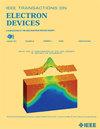用于高灵敏度生物传感器的负电容场效应晶体管的解析建模
IF 3.2
2区 工程技术
Q2 ENGINEERING, ELECTRICAL & ELECTRONIC
引用次数: 0
摘要
传统场效应晶体管(fet)的亚阈值摆幅(SS)在室温下基本上被限制在60 mV/dec,这严重限制了生物传感器有效检测微弱生物信号的灵敏度。为了解决这一瓶颈,我们提出了一个全面的、基于物理的、电路兼容的二维材料负电容场效应晶体管(NCFET)生物传感器分析模型。该模型首次采用了包含HfZrO (HZO)铁电层的顶栅架构,旨在与标准半导体制造工艺完全兼容。它为准确预测NCFET生物传感器(NC-BioFET)的性能提供了一个强大的理论框架,并解决了传统fet的局限性。以n-WSe2 NCFET生物传感器为例,我们通过广泛的仿真验证了该模型,实现了低至30 mV/dec的SS,并展示了出色的pH传感性能。在模型构建的水环境中,该传感器表现出令人印象深刻的pH检测灵敏度,为1799/pH,显著优于传统FET生物传感器的461/pH灵敏度。此外,为了验证模型的准确性,我们制作了WSe2 NCFET生物传感器,并测试了它们在ph范围内的响应。该模型在漏极电流、SS和电压/电流灵敏度方面与实验结果非常吻合。本研究为高性能、低功耗生物传感器的设计和优化奠定了坚实的理论和实验基础。它还弥合了NCFET技术和生物传感应用之间的差距,为具有超高灵敏度和卓越信号检测能力的下一代生物传感器铺平了道路。本文章由计算机程序翻译,如有差异,请以英文原文为准。
Analytical Modeling of Negative Capacitance Field-Effect Transistor for Highly Sensitive Biosensor Applications
The subthreshold swing (SS) of conventional field-effect transistors (FETs) is fundamentally limited to 60 mV/dec at room temperature, which significantly constrains the sensitivity of biosensors in detecting weak biological signals effectively. To address this bottleneck, we present a comprehensive, physics-based, and circuit-compatible analytical model for a 2-D material negative capacitance FET (NCFET) biosensor. The model features a top-gate architecture incorporating a HfZrO (HZO) ferroelectric layer for the first time, designed to be fully compatible with standard semiconductor fabrication processes. It provides a robust theoretical framework for accurately predicting the performance of NCFET biosensors (NC-BioFET) and addresses the limitations of traditional FETs. Using an n-WSe2 NCFET biosensor as an example, we validate the model through extensive simulations, achieving an SS as low as 30 mV/dec and demonstrating excellent pH sensing performance. In a model-constructed aqueous environment, the sensor exhibits an impressive pH detection sensitivity of 1799/pH, significantly outperforming the 461/pH sensitivity observed in its conventional FET biosensor. Furthermore, to validate the accuracy of the model, we fabricated WSe2 NCFET biosensors and tested their response across a range of pH. The model shows excellent agreement with experimental results in terms of drain current, SS, and voltage/current sensitivity. This work establishes a robust theoretical and experimental foundation for the design and optimization of high-performance and low-power biosensors. It also bridges the gap between NCFET technology and biosensing applications, paving the way for next-generation biosensors with ultrahigh sensitivity and superior signal detection capabilities.
求助全文
通过发布文献求助,成功后即可免费获取论文全文。
去求助
来源期刊

IEEE Transactions on Electron Devices
工程技术-工程:电子与电气
CiteScore
5.80
自引率
16.10%
发文量
937
审稿时长
3.8 months
期刊介绍:
IEEE Transactions on Electron Devices publishes original and significant contributions relating to the theory, modeling, design, performance and reliability of electron and ion integrated circuit devices and interconnects, involving insulators, metals, organic materials, micro-plasmas, semiconductors, quantum-effect structures, vacuum devices, and emerging materials with applications in bioelectronics, biomedical electronics, computation, communications, displays, microelectromechanics, imaging, micro-actuators, nanoelectronics, optoelectronics, photovoltaics, power ICs and micro-sensors. Tutorial and review papers on these subjects are also published and occasional special issues appear to present a collection of papers which treat particular areas in more depth and breadth.
 求助内容:
求助内容: 应助结果提醒方式:
应助结果提醒方式:


